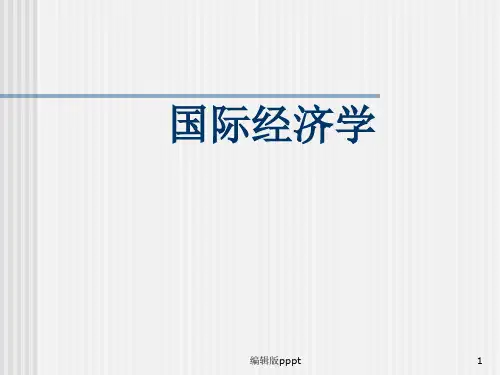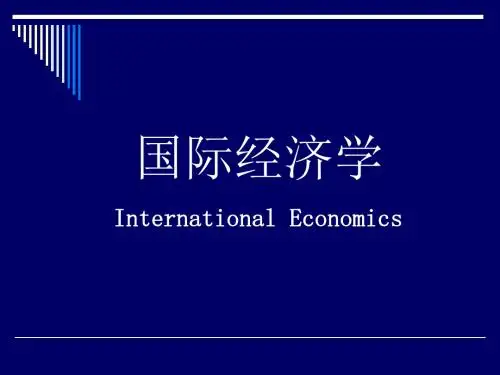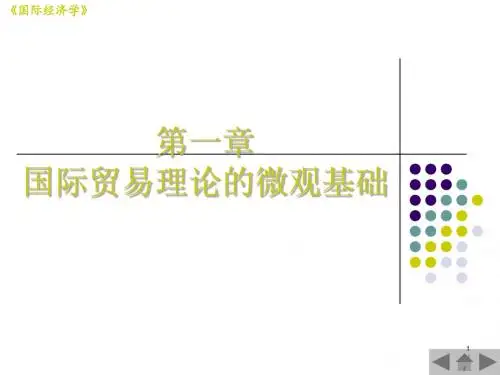2019精品国际经济学双语第1章语文
- 格式:ppt
- 大小:542.56 KB
- 文档页数:49
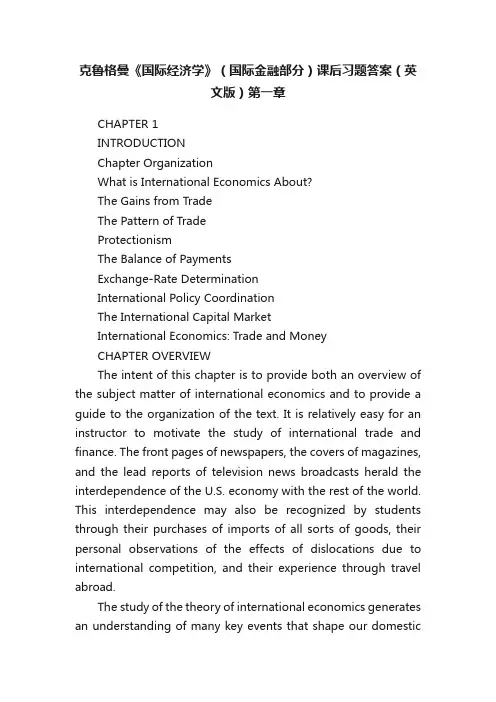
克鲁格曼《国际经济学》(国际金融部分)课后习题答案(英文版)第一章CHAPTER 1INTRODUCTIONChapter OrganizationWhat is International Economics About?The Gains from TradeThe Pattern of TradeProtectionismThe Balance of PaymentsExchange-Rate DeterminationInternational Policy CoordinationThe International Capital MarketInternational Economics: Trade and MoneyCHAPTER OVERVIEWThe intent of this chapter is to provide both an overview of the subject matter of international economics and to provide a guide to the organization of the text. It is relatively easy for an instructor to motivate the study of international trade and finance. The front pages of newspapers, the covers of magazines, and the lead reports of television news broadcasts herald the interdependence of the U.S. economy with the rest of the world. This interdependence may also be recognized by students through their purchases of imports of all sorts of goods, their personal observations of the effects of dislocations due to international competition, and their experience through travel abroad.The study of the theory of international economics generates an understanding of many key events that shape our domesticand international environment. In recent history, these events include the causes and consequences of the large current account deficits of the United States; the dramatic appreciation of the dollar during the first half of the 1980s followed by its rapid depreciation in the second half of the 1980s; the Latin American debt crisis of the 1980s and the Mexico crisis in late 1994; and the increased pressures for industry protection against foreign competition broadly voiced in the late 1980s and more vocally espoused in the first half of the 1990s. Most recently, the financial crisis that began in East Asia in 1997 andspread to many countries around the globe and the Economic and Monetary Union in Europe have highlighted the way in which various national economies are linked and how important it is for us to understand these connections. At the same time, protests at global economic meetings have highlighted opposition to globalization. The text material will enable students to understand the economic context in which such events occur.Chapter 1 of the text presents data demonstrating the growth in trade and increasing importance of international economics. This chapter also highlights and briefly discusses seven themes which arise throughout the book. These themes include: 1) the gains from trade;2) the pattern of trade; 3) protectionism; 4), the balance of payments; 5) exchange rate determination; 6) international policy coordination; and 7) the international capital market. Students will recognize that many of the central policy debates occurring today come under the rubric of one of these themes. Indeed, it is often a fruitful heuristic to use current events to illustrate the force of the key themes and arguments which are presentedthroughout the text.。

PART I INSTRUCTOR’S MANUALCHAPTER 1THE INTERNATIONAL ECONOMYCHAPTER OVERVIEWThis chapter introduces students to the international economy. The first part of the chapter emphasizes the high degree of economic interdependence that charac terizes today’s economies. Economic interdependence includes international trade and international finance.The chapter also focuses on the United States as an open economy. Data are provided that show U.S. exports as a percent of gross domestic product and the value of U.S. trade with its major trading partners. The chapter notes that many U.S. firms source a portion of the production of their goods in foreign countries.The chapter concludes by discussing the nature of international competitiveness--for firms, industries, and nations. It is noted that exposure to global competition tends to improve the efficiency of firms. Finally, the chapter introduces the potential effects that international trade has on workers.After completing the chapter, students should be able to:∙Define economic interdependence.∙Discuss the importance of international trade for the U.S. economy.∙Examine the factors that make a company American.∙Discuss the nature of competitiveness and how it applies to firms, industries, and nations.∙Identify the advantages and disadvantages of international trade for workers.BRIEF ANSWERS TO STUDY QUESTIONS1. Interdependence among today's economies reflects the historical evolution of the world's economic andpolitical order. Since World War II, Europe and Japan have reindustrialized. What is more, theformation of the European Community and the Organization of Petroleum Exporting Countries, as well as the rise of multinational corporations, has contributed to closer economic and political linkages.2. Proponents of an open trading system maintain that free trade leads to lower prices, the development ofmore efficient production methods, and a greater range of consumption choices. Free trade permitsresources to move from their lowest productivity to their highest productivity. Critics of an open trading system maintain that import competition may displace domestic firms and workers. It is also argued that during periods of national emergency, it is in the best interests of a nation to protect strategic industries.3. For the United States, growing economic interdependence has resulted in exports and imports increasingas a share of national output. Profits of domestic firms and wages of domestic workers are increasingly being affected by foreign competition. Political and economic events play important roles for theoperation of some sectors of the American economy, such as energy and agriculture.4. The volume of international trade is governed by factors including the level of domestic economic activity(e.g., prosperity versus recession) and restrictions imposed by countries on their imports.5. The chapter describes three fallacies of international trade:a. Trade is a zero sum activityb. Imports reduce employment and act as a drag on the economyc. Tariffs and quotas will save jobs and promote a higher level of employment6. International competitiveness refers to the extent to which the goods of a firm or industry can compete inthe marketplace; this competitiveness depends on the relative prices and qualities of products. No nation can be competitive in, and thus be a net exporter of everything. Because a nation’s stock of resources is limited, the ideal is for these resources to be used in their most productive manner. Nations will benefit from specialization and trade by exporting products having a comparative advantage.7. Researchers at the McKinsey Global Institute have found that global competitiveness is a bit like sports.You get better by playing against folks who are better than you. This means companies are exposed to intense global competition tend to be more productive than those who aren’t.8.International trade benefits most workers, especially those in exporting industries. In addition to providingthem jobs and income, it allows them to shop for consumption goods that are cheapest and of the highest quality. However, workers in import-competing industries often feel threatened from competition ofcheap foreign labor.9.Among the challenges confronting the international trading system are maintaining fair standards for laborand promoting environmental quality.10.The threat of international terrorism tends to slow the degree of globalization and also make it becomecostlier. With terrorism, companies must pay more to insure and provide security for overseas staff and property. Heightened border inspections could slow shipments of cargo, forcing companies to stockmore inventory. Tighter immigration policies could reduce the liberal inflows of skilled and blue-collar laborers that permitted companies to expand while keeping wages in check. Moreover, a greaterpreoccupation with political risk has companies greatly narrowing their horizons when making newinvestments.。
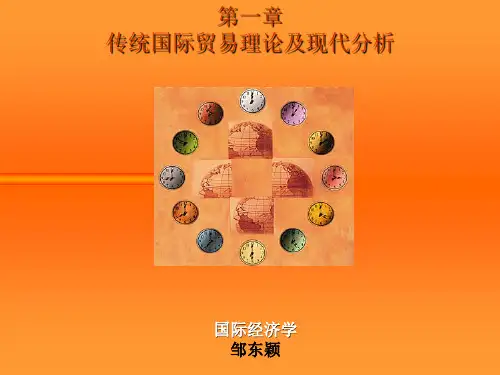

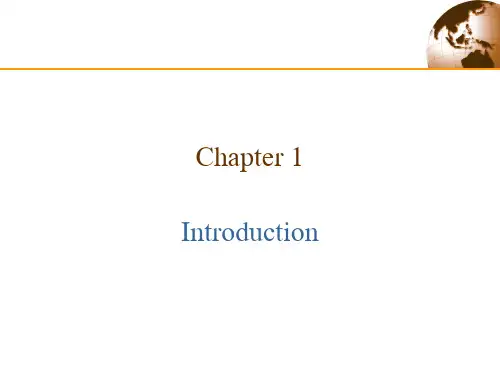



Chapter 1 Introduction1.1 What Is International Economics About?1) Historians of economic thought often describe ________ written by ________ and published in ________ asthe first real exposition of an economic model.A) "Of the Balance of Trade," David Hume, 1776B) "Wealth of Nations," David Hume, 1758C) "Wealth of Nations," Adam Smith, 1758D) "Wealth of Nations," Adam Smith, 1776E) "Of the Balance of Trade," David Hume, 1758Answer: EQuestion Status: Previous Edition2) From 1959 to 2004,A) the U.S. economy roughly tripled in size.B) U.S. imports roughly tripled in size.C) the share of US Trade in the economy roughly tripled in size.D) U.S. Imports roughly tripled as compared to U.S. exports.E) U.S. exports roughly tripled in size.Answer: CQuestion Status: Previous Edition3) The United States is less dependent on trade than most other countries becauseA) the United States is a relatively large country.B) the United States is a "Superpower."C) the military power of the United States makes it less dependent on anything.D) the United States invests in many other countries.E) many countries invest in the United States.Answer: AQuestion Status: Previous Edition4) Ancient theories of international economics from the 18th and 19th Centuries areA) not relevant to current policy analysis.B) are only of moderate relevance in today's modern international economy.C) are highly relevant in today's modern international economy.D) are the only theories that actually relevant to modern international economy.E) are not well understood by modern mathematically oriented theorists.Answer: CQuestion Status: Previous Edition5) An important insight of international trade theory is that when countries exchange goods and services onewith the other itA) is always beneficial to both countries.B) is usually beneficial to both countries.C) is typically beneficial only to the low wage trade partner country.D) is typically harmful to the technologically lagging country.E) tends to create unemployment in both countries.Answer: BQuestion Status: Previous EditionB) trade is likely to be harmful to the country with the high wages.C) trade is likely to be harmful to the country with the low wages.D) trade is likely to be harmful to neither country.E) trade is likely to have no effect on either country.Answer: DQuestion Status: Previous Edition7) Benefits of international trade are limited toA) tangible goods.B) intangible goods.C) all goods but not services.D) services.E) None of the above.Answer: EQuestion Status: Previous Edition8) Which of the following does not belong?A) NAFTAB) Uruguay RoundC) World Trade OrganizationD) None Tariff BarriersE) None of the above.Answer: DQuestion Status: Previous Edition9) International economics does not use the same fundamental methods of analysis as other branches ofeconomics, becauseA) the level of complexity of international issues is unique.B) the interactions associated with international economic relations is highly mathematical.C) international economics takes a different perspective on economic issues.D) international economic policy requires cooperation with other countries.E) None of the above.Answer: EQuestion Status: New10) Because the Constitution forbids restraints on interstate trade,A) the U.S. may not impose tariffs on imports from NAFTA countries.B) the U.S. may not affect the international value of the $ U.S.C) the U.S. may not put restraints on foreign investments in California if it involves a financialintermediary in New York State.D) the U.S. may not impose export duties.E) None of the aboveAnswer: EQuestion Status: NewB) the balance of paymentsC) exchange rate determinationD) Bilateral trade relations with ChinaE) None of the aboveAnswer: DQuestion Status: New12) "Trade is generally harmful if there are large disparities between countries in wages."A) This is generally true.B) This is generally false.C) Trade theory has nothing to say about this issue.D) This is true if the trade partner ignores child labor laws.E) This is true if the trade partner uses prison labor.Answer: BQuestion Status: New13) Who sells what to whomA) has been a major preoccupation of international economics.B) is not a valid concern of international economics.C) is not considered important for government foreign trade policy since such decisions are made in theprivate competitive market.D) is determined by political rather than economic factors.E) None of the aboveAnswer: AQuestion Status: New14) The insight that patterns of trade are primarily determined by international differences in labor productivitywas first proposed byA) Adam Smith.B) David Hume.C) David Ricardo.D) Eli Heckscher.E) Lerner and Samuelson.Answer: CQuestion Status: New15) Since the mid 1940s, the United States, has pursued a broad policy ofA) strengthening "Fortress America" protectionism.B) removing barriers to international trade.C) isolating Iran and other axes of evil.D) protecting the U.S. from the economic impact of oil producers.E) None of the above.Answer: BQuestion Status: NewB) the U.S. economy cannot grow when the balance of payments is in deficit.C) the U.S. has run huge trade deficits in every year since 1982.D) the U.S. never experienced a surplus in its balance of payments.E) None of the above.Answer: CQuestion Status: New17) The euro, a common currency for most of the nations of Western Europe, was introducedA) before 1900.B) before 1990.C) before 2000.D) in order to snub the pride of the U.S.E) None of the above.Answer: CQuestion Status: New18) During the first three years of its existence, the euroA) depreciated against the $U.S.B) maintained a strict parity with the $U.S.C) strengthened against the $U.S.D) proved to be an impossible dream.E) None of the above.Answer: AQuestion Status: New19) The study of exchange rate determination is a relatively new part of international economics, since,A) for much of the past century, exchange rates were fixed by government action.B) the calculations required for this were not possible before modern computers became available.C) economic theory developed by David Hume demonstrated that real exchange rates remain fixed overtime.D) dynamic overshooting asset pricing models are a recent theoretical development.E) None of the aboveAnswer: AQuestion Status: New20) A fundamental problem in international economics is how to produceA) a perfect degree of monetary harmony.B) an acceptable degree of harmony among the international tradepolicies of different countries.C) a world government that can harmonize trade and monetary policiesD) a counter-cyclical monetary policy so that all countries will not be adversely affected by a financialcrisis in one country.E) None of the above.Answer: BQuestion Status: NewB) by the International Monetary Fund.C) by the World.D) by an international treaty known as the General Agreement on Tariffs and Trade (GATT).E) None of the above.Answer: DQuestion Status: New22) The international capital market isA) the place where you can rent earth moving equipment anywhere in the world.B) a set of arrangements by which individuals and firms exchange money now for promises to pay in thefuture.C) the arrangement where banks build up their capital by borrowing from the Central Bank.D) the place where emerging economies accept capital invested by banks.E) None of the above.Answer: BQuestion Status: New23) International capital markets experience a kind of risk not faced in domestic capital markets, namelyA) "economic meltdown" risk.B) Flood and hurricane crisis risk.C) the risk of unexpected downgrading of assets by Standard and Poor.D) exchange rate risk.E) None of the above.Answer: DQuestion Status: New24) Since 1994, trade rules have been enforced byA) the WTO.B) the G10.C) the GATT.D) The U.S. Congress.E) None of the above.Answer: AQuestion Status: New25) In 1998 an economic and financial crisis in South Korea caused it to experienceA) a surplus in their balance of payments.B) a deficit in their balance of payments.C) a balanced balance of payments.D) an unbalanced balance of payments.E) None of the above.Answer: AQuestion Status: Newtrade meeting in Seattle ofA) the OECD.B) NAFTA.C) WTO.D) GATT.E) None of the above.Answer: CQuestion Status: New27) International Economists cannot discuss the effects of international trade or recommend changes ingovernment policies toward trade with any confidence unless they knowA) their theory is the best available.B) their theory is internally consistent.C) their theory passes the "reasonable person" legal criteria.D) their theory is good enough to explain the international trade that is actually observed.E) None of the above.Answer: DQuestion Status: New28) Trade theorists have proven that the gains from tradeA) must raise the economic welfare of every country engaged in trade.B) must raise the economic welfare of everyone in every country engaged in trade.C) must harm owners of "specific" factors of production.D) will always help "winners" by an amount exceeding the losses of "losers."E) None of the above.Answer: EQuestion Status: New1.2 International Economics: Trade and Money1) Cost-benefit analysis of international tradeA) is basically useless.B) is empirically intractable.C) focuses attention primarily on conflicts of interest within countries.D) focuses attention on conflicts of interests between countries.E) None of the above.Answer: CQuestion Status: Previous Edition2) An improvement in a country's balance of payments means a decrease in its balance of payments deficit, oran increase in its surplus. In fact we know that a surplus in a balance of paymentsA) is good.B) is usually good.C) is probably good.D) may be considered bad.E) is always bad.Answer: DQuestion Status: Previous EditionA) an international treaty.B) an international U.N. agency.C) an international IMF agency.D) a U.S. government agency.E) a collection of tariffs.Answer: AQuestion Status: Previous Edition4) The international debt crisis of early 1982 was precipitated when ________ could not pay its internationaldebts.A) RussiaB) MexicoC) BrazilD) MalaysiaE) ChinaAnswer: BQuestion Status: Previous Edition5) International economics can be divided into two broad sub-fieldsA) macro and micro.B) developed and less developed.C) monetary and barter.D) international trade and international money.E) static and dynamic.Answer: DQuestion Status: Previous Edition6) International monetary analysis focuses onA) the real side of the international economy.B) the international trade side of the international economy.C) the international investment side of the international economy.D) the issues of international cooperation between Central Banks.E) None of the above.Answer: EQuestion Status: New7) The distinction between international trade and international money is not useful sinceA) real developments in the trade accounts have monetary implications.B) the balance of payments includes both real and financial implications.C) developments caused by purely monetary changes have real effects.D) trade models focus on real, or barter relationships.E) None of the above.Answer: EQuestion Status: NewWhat are the logical underpinnings of this argument?Answer: Yes. They do not have sufficient resources to satisfy consumption needs; and also do not have a sufficiently large market to enable their industries to avail themselves of scale economy possibilities.Another answer would rely on a location argument. Assume that the "natural" market for any givenplant is a circle with a radius of n miles with the plant at its center. Assuming that the productionplants are located randomly throughout the country, then the probability that the typical circularmarket will encompass some foreign country is greater the smaller is the country.Question Status: Previous Edition9) It is argued that if a rich high wage country such as the United States were to expand trade with a relativelypoor and low wage country such as Mexico, then U.S. industry would migrate south, and U.S. wages would fall to the level of Mexico's. What do you think about this argument?Answer: The student may think anything. The purpose of the question is to set up a discussion, which will lead to the models in the following chapters.Question Status: Previous Edition10) Some patterns of international trade are easier to explain than others. Give several examples and explain.Answer: Historical circumstance can explain some patterns such as the relatively large trade flows from West Africa to France. The relatively sparse trade between countries within South America seems curious.Question Status: Previous Edition11) International trade tends to prove that international trade is beneficial to all trading countries. However,casual observation notes that official obstruction of international trade flows is widespread. How might you reconcile these two facts?Answer: This question is meant to allow students to offer preliminary discussions of issues, which will be explored in depth later in the book.Question Status: Previous Edition12) It is argued that small countries tend have more open economies than large ones. Is this empirically verified?What are the logical underpinnings of this argument?Answer: Yes. They do not have sufficient resources to satisfy consumption needs; and also do not have a sufficiently large market to enable their industries to avail themselves of scale economy possibilities.Another answer would rely on a location argument. Assume that the "natural" market for any givenplant is a circle with a radius of n miles with the plant at its center. Assuming that the productionplants are located randomly throughout the country, then the probability that the typical circularmarket will encompass some foreign country is greater the smaller is the country.Question Status: Previous Edition13) It is argued that if a rich high wage country such as the United States were to expand trade with a relativelypoor and low wage country such as Mexico, then U.S. industry would migrate south, and U.S. wages would fall to the level of Mexico's. What do you think about this argument?Answer: The student may think anything. The purpose of the question is to set up a discussion, which will lead to the models in the following chapters.Question Status: Previous Edition14) Some patterns of international trade are easier to explain than others. Give several examples and explain.Answer: Historical circumstance can explain some patterns such as the relatively large trade flows from West Africa to France. The relatively sparse trade between countries within South America seems curious.Question Status: Previous Editioncasual observation notes that official obstruction of international trade flows is widespread. How might you reconcile these two facts?Answer: This question is meant to allow students to offer preliminary discussions of issues, which will be explored in depth later in the book.Question Status: Previous Edition16) International Trade theory is one of the oldest areas of applied economic policy analysis. It is also an area forwhich data was relatively widely available very early on. Why do you suppose this is the case?Answer: In ancient times, public finance was not well developed. Most of the population was not producing and consuming within well-developed market economies, so that income and sales taxes were notefficient. One of the most convenient ways for governments to obtain resources was to set up customposts at borders and tax. Hence international trade was of great policy interest to princes and kings, aswas precise data of their main tax base.Question Status: Previous Edition17) The figure above is the Production Possibility Frontier (PPF) of Baccalia, where only two products areproduced, clothing and wine. In fact Baccalia is producing on its PPF at point A. By and large the people of Baccalia are content, as both their external and internal needs for warmth are satisfied in the mosteconomically efficient manner possible, given their available productive resources (and known technology).How much wine is being produced? How much cloth? If a person in this country wanted to purchase a liter of wine, what would be the price he or she would have to pay?Judging from what you learned in the previous paragraph, can you indicate at which point (if at all) the Community Indifference Curve is tangent to the Production Possibility Frontier? Explain your reasoning.Answer: 6 million liters of wine are being produced.3 million square yards of cloth are being produced.The price of 1 liter of wine is one half of a square yard of cloth.The tangency is at point A. We know this because otherwise the country would not be producing atthe point of maximum economic efficiency.Question Status: Previous Edition18) One day, Baccalia joined the WTO and joined the Global Village. They discovered that in the LWE (LondonWine Exchange), 1 liter of wine is worth 1 square yard of cloth. What is the logical production point they should strive for? (See figure.)Answer: 10 million liters of wine.Question Status: Previous Edition19) Baccalia wishes to enjoy to the fullest from the gains from trade, but is not willing to give up imbibing evenone drop of wine from the 6 million liters they consumed in their original autarkic state. If their newconsumption point is a point we shall designate as point b, describe where this point would be found. (See figure.)Answer: Vertically above point aQuestion Status: Previous Edition20) Where is the Community Indifference Curve family of curves tangent to their new Consumption PossibilityFrontier?Answer: At point b.Question Status: Previous Edition21) How can you prove that Baccalia has in fact gained from the availability of trade, and that their newsituation is superior to the pre-trade situation (with which they were quite content)?Answer: The country was consuming at point a before trade. It is now consuming at point b with trade. Point b represents a superior welfare combination of goods as compared to point a, since at b the country hasmore of each of the goods.Question Status: Previous Edition。
